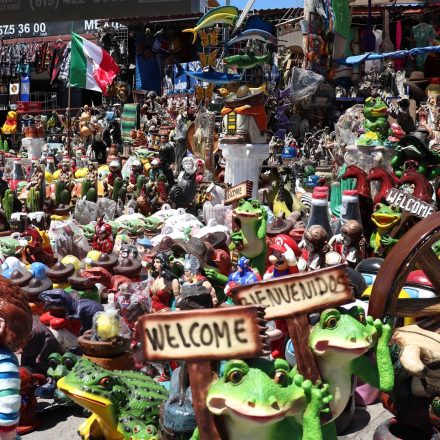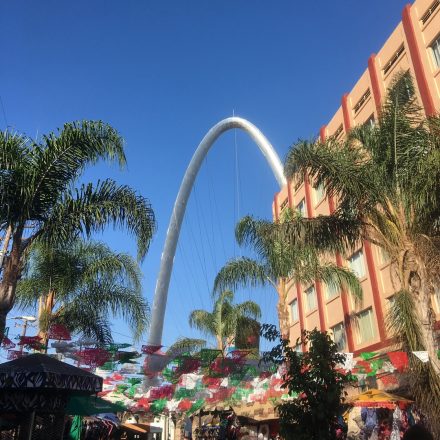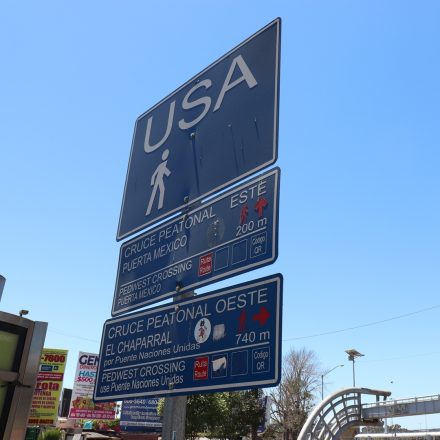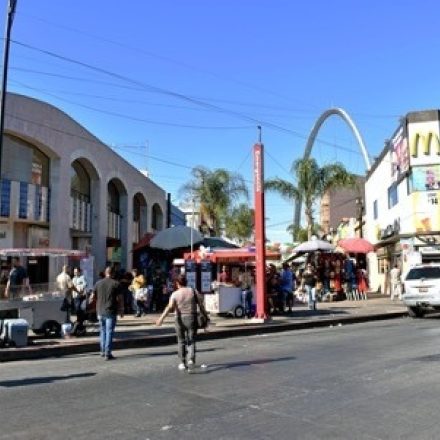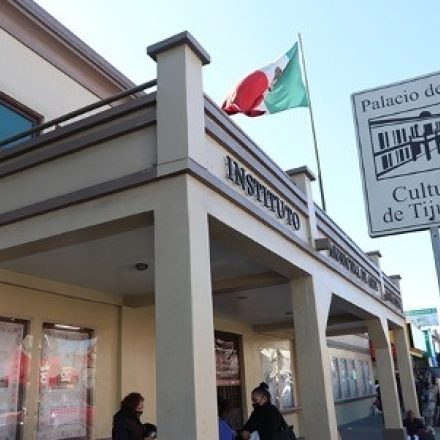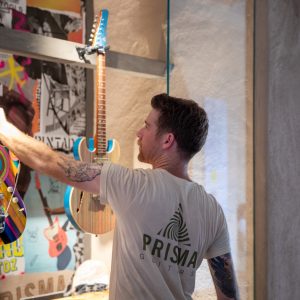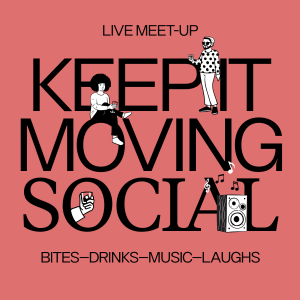Tatiana Perez is an architect who graduated from the Universidad Iberoamericana CDMX-Tijuana (2016). She’s collaborated with the architecture office "Amorphica Design Research Office" and with the Emerging + Sustainable Communities foundation. Since 2017 she has been the assistant professor at the Universidad Iberoamericana CDMX-Tijuana.
Since 2015, she has collaborated with Se Hace Arquitectura, an office dedicated to architectural and urban design.
Self-Guided Tours
Border Inspiration: Downtown Tijuana Pedestrian Route by Tatiana Perez / Se Hace Arquitectura
What this is
Self-guided tours allow you to discover design sites around San Diego and Tijuana, on your own.
When & Where
All week
- Free Register
Tags
Urban, Education, Architecture

Take a self-guided tour through Tijuana and reflect on what the city aspires to be.
Tijuana-San Diego Walking Tour
Discover the walkability from the border crossing to downtown Tijuana. The Tijuana-San Diego region has the busiest border in the world, and despite the fact that it has this pedestrian route that connects two of the most important areas of the city, many people are unaware of it and choose to use cabs and public transportation because they are available to them.
My interest in this pedestrian route began in 2015, during a college class where the proposed research topic had to be of personal interest. Walking and observing the city have always been constant activities in my life, experiencing any city this way has always led me to rethink and imagine how I would like the spaces I inhabit to be. Naturally, the choice of subject matter could not be other than this tour. The response to the spaces corresponds to the situation being
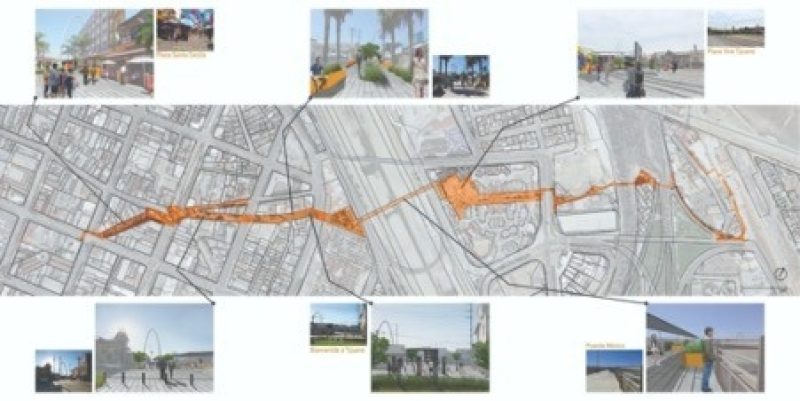
Currently, the situation of the city has changed and these spaces need new possible futures. This narration of the tour is an invitation to walk them and imagine what they could become.
Navigating the streets of Tijuana can be confusing and intimidating for many, but there is no area more vibrant, dynamic, and inspiring than downtown, the final destination of this tour. It all starts when you cross the border at the East Pedestrian Border Crossing. You're sure to find people singing on loudspeakers, someone offering transportation, someone selling some kind of Mexican snack, and someone else promoting a "quick" method to get back across the border. Depending on the day and time, you will see hundreds of people standing in line, waiting to cross the border into the United States. Such a unique activity to the region. Where else do you see this at all hours of the day? It makes you wonder, what are we as a city offering with this space? How are the hundreds of people who walk through it every day experiencing it?
Continuing the tour, you will cross a pedestrian bridge and walk across the car lanes where even more people wait to cross, but now you will move along the "curios" stands. A landscape full of handicrafts, blankets, overcoats, and an endless number of piggy banks of all shapes and sizes. A sea of textures and colors that invite you to create. But this space was not always like this. The need to create more car lanes led to the demolition of a building of architectural value to the city known as Puerta Mexico. The loss of this building has motivated small groups of citizens, including myself, to continue seeking to rescue and conserve other important buildings for the city. The footprint of what existed became the inspiration to fight for the conservation of other spaces.
The next point of interest in the tour is precisely a building from the 1940s that was retaken and converted into a small mixed-use complex: the Federal Station. This has become one of the spots adopted by the artistic community of the region–a nice place where you can enjoy a coffee, cocktails or delicious food.
Just a few meters from the Federal Station, is the West Pedestrian Border Crossing. Although it is temporarily closed, the public space generated around it and its direct connection to the Plaza Viva Tijuana make it extremely relevant. Plaza Viva Tijuana, an open mall from the 90's with a postmodernist architecture, has been almost completely abandoned for years. When you see this shopping center you can only imagine what they envisioned for it at the time: a plaza full of activity, with "curios" stands, pharmacies, and nightclubs. But now it is only used as a forced passageway to get to downtown and as a meeting point for migrants. Its appearance has reached such a degree of abandonment and deterioration that it inspires a post-apocalyptic feeling, to such a degree that it was even used as part of the locations for the famous series "Fear The Walking Dead". It is impossible to visit this plaza without imagining what it could be or even using it as inspiration for different artistic projects, as it has already happened.
At one end of Plaza Viva Tijuana is Puente Mexico or Puente Chaparral, which spans the channel of the Tijuana River. From the bridge you can see both cities, the river that connects them and the metal wall that intersects them. From here you can see the object that has been the cause of multiple controversies, artistic projects, criticisms and news. The wall has inspired multiple creations, will yours be next?
As you go down the bridge, you arrive at Las Californias Park, a small public space that is quite well preserved. On one side of the park you will find the Handicraft Market. Among its narrow alleys and passageways you will find a great variety of articles made by local artisans with techniques from all over the country. Currently some of the shops are abandoned, but feeling these neglected spaces, almost resembling a labyrinth full of curiosities transports you and invites you to continue exploring.
As you cross the street from Parque Las Californias, you will see the arch that welcomes you to the city. It is here where you begin to take your first steps in the Zona Centro. This block has a large number of stores, unfortunately many of them closed. Despite being quite busy, the pandemic and the decrease in tourism wreaked havoc, but that only leaves us now with a blank canvas with which to experiment and highlight the potential of the area.
The next point of interest in this tour is the Wax Museum. Founded in the 90's, it is a small museum displaying the figures of famous people from Mexico's history. From this point you can clearly see the Arch and Monumental Clock, and as you walk towards it, you will see some murals by local artists.
As you stand below the Arch and Monumental Clock you will see Avenida Revolucion, the most important commercial and touristic walkway of the city. On this avenue there is a variety of stores with local design products, old passageways, local breweries and restaurants, such as Caesar's, where the recipe for the Caesar salad was created.
As the tour continues, you will arrive at Plaza Santa Cecilia which is the last existing diagonal street of the original layout of the city. Known for being the place of eternal celebration, mariachi groups await requests for their services either for one song or for a few hours. In this picturesque alley, full of color and Mexican joy, you will have many options to taste a margarita, buy all kinds of souvenirs, as well as typical Mexican clothing offered in Pasaje Colonial, which you can access from this point. Walking through the alley exposes you to an experience similar to walking through a traditional Mexican village.
The tour concludes when you cross Plaza Santa Cecilia and the street to the Municipal Institute of Art and Culture, another historic building (although modified) where the Tijuana History Museum and the City's Historical Archive are located. Here you can learn more about the city and continue exploring other parts of it that may have caught your attention.
![]()
Photo: Tatiana Perez ![]()

